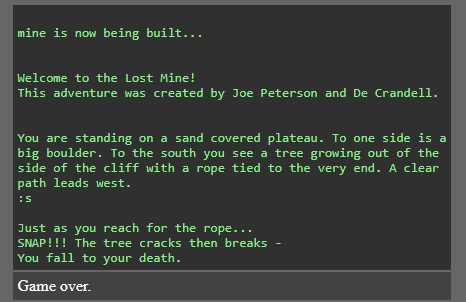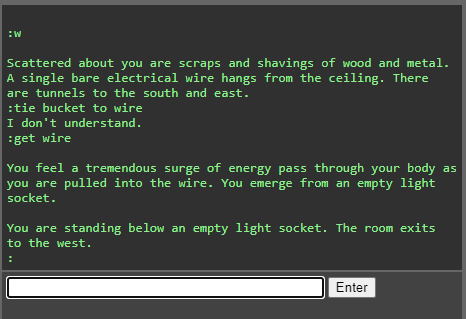Behind the scenes here at All the Adventures, the way I started 1982 was to dump the entirety of CASA’s database for that year into a spreadsheet, add games I knew it had missing (either cross-referenced to Mobygames, or from my own research) and use a randomizer tool. So I theoretically have a list of the order of all games I will be playing up to the end of 1982.
However, the list has many messy notes, and I quite often deviate. I try to keep my “big games” to be at a pace of once every five or so, I try to keep a good mix of platforms and origin countries, and with multiple games by the same company / magazine / person I try to spread them out over the year. Sometimes I’ll find a game is best considered with a pair (like the two recent VIC-20 games by Charles Sharp Jr.). Sometimes I’ll add a little hidden theming.
And sometimes, well, I don’t have any master plan at all, but here: my next game from the spreadsheet is probably janky, and I just wrapped up (mostly) The Haunted Palace. I just didn’t have the willpower. I dug around to find a game that was a.) short and b.) probably had a semi-reliable parser. Enchanted Cave by De Crandell and Joe Peterson mostly fit the description, so I decided to give their next game using their same homebrew TRS-80 engine (EXPLORE) a try. No need for new history background, even, since everything about them got covered in my last post.
The most memorable part of Enchanted Cave for me were the “trap” red herrings, like a key which unlocks two different doors, but the more obviously available of the two kills you. (There’s a clue warning about this beforehand. It wouldn’t be “fun” if it was just a left-right door thing where only one is correct, but with the “fake door” being in a totally different and more accessible place than the real one it diverged into comedy.)
The authors must have liked that moment too, because they put a similar one in at the very start of Lost Mine.

Taking a climb down the already-available rope is death.

Rather, what you’re supposed to do is move the boulder, revealing a new rope, then take it down to a nearby spot with a cactus and climb down there instead.

The “steel grate through which you can see a large room” will be important later.
This is also like Enchanted Cave in that we are given no motivation to start with. That game had no treasures to collect; this one doesn’t either. We’re going into a strange and dangerous area and trying to get out the other side alive for … fun? Sure, I can roll with that, it is a good overall metaphor for adventure-game-playing anyway.

Despite two more sudden trap-deaths later, the game’s emphasis on making a tight and straightforward puzzle-laden experience. This feels less aimless than the authors’ previous game.

After heading down the rope, you go down into the bottom part of the mine complex (marked dark blue). There’s a “ghastly sight” with a skeleton that “appears it hasn’t eaten in a hundred years” the end of a long chute, a room with a bucket and “glass cutter” inside, and what looks like an “emergency case” of glass which contains a miner’s pick.

Not a tough puzzle. If you try to break the case, an alarm sounds and guards (where do they come from?!) arrive and riddle your body with bullets.
The pick can go back a little bit to a wall near the elevator and let you dig through. There you will find a food container (!?) which can then be taken to the skeleton who hasn’t eaten in a while.

Magic word in hand, you can then head upstairs (pink/purple on the map).

There you can find a mine cart with a third (and I believe last) instant death scene.

There’s also a curious room with symbols of lightning bolts followed by a room that asks you to insert a coin in a slot (that is lit by a grate exposed to the outside). There’s also a pit that appears to have something on the other side but is too large to jump. These will be dealt with in a moment; the next thing to do is to grab a “bare electrical wire” which does not kill you but rather sends you through the wire to an outlet on the other side.

This drops you in a small area with a “round slab of rock” that has a spear with a rope. ZWOOF which we got from the skeleton works here:

I admit this is the last room I tested, but fortunately it isn’t a big map.
The spear/rope combo can be used on the pit to then get a coin.

Normally the coin would then go straight to the coin slot, but you get zapped trying to carry it to the appropriate room (the one with the lightning bolt symbols is along the path). The clever bit here is to put together the grate seen above-ground with the the fact you can see the same grate down below in the coin slot room.


The hacksaw can then be used on the last obstacle (the minecart) to achieve victory.

This game was solid, pleasant, and oddly kind of rare. Yes, the setting is incoherent and pretty much generated around the puzzles (feeding a skeleton? hacksaw for a coin?), but those puzzles were straightforward, not attempting to be too hard, and even led to one clever moment (the grate connection). The engine doesn’t seem to be able to handle complex daemons and the like; I’ve said before this can be a great weakness of some games, but that’s only if they endeavor to be chock-full of hard puzzles in the first place.
The parser isn’t even that good, really; it only understands a small sample of words. But the game never tried to do anything so ambitious that it wasn’t already clear how to do what the game was asking for; it’s all bread-and-butter verbs like CUT, THROW, and CLIMB.
We’ll see if that pleasant buzz continues, because I’m going to now play the game I was hesitant about before, and the return of the company Aardvark. They’re the ones that published Deathship, arguably with the worst parser ever made, and with only incremental improvement in their games after. I’m hoping they’ve learned enough now from experience.
Leave a comment